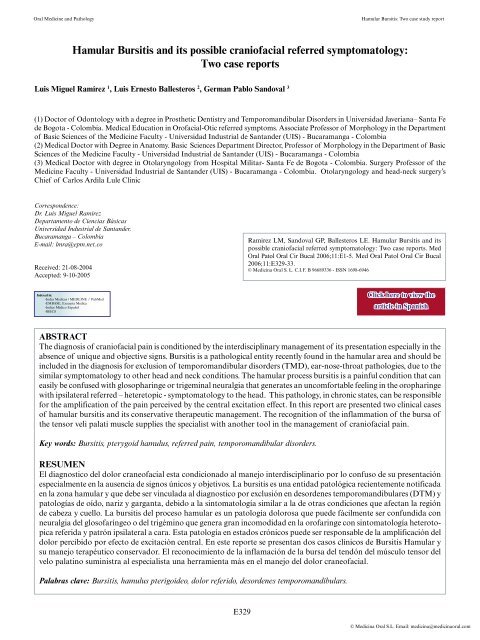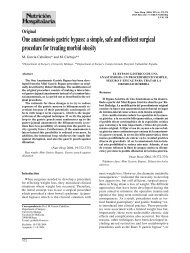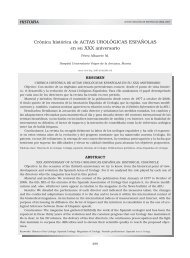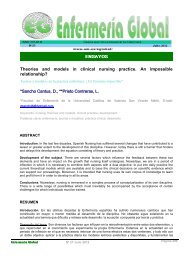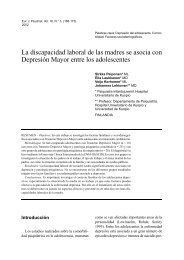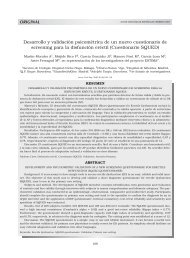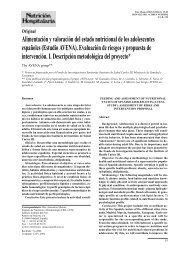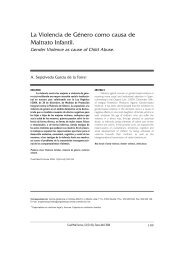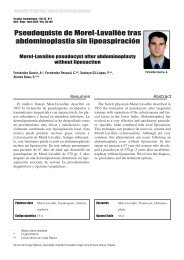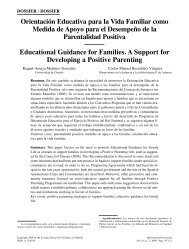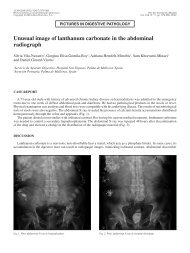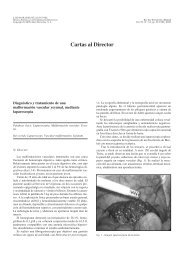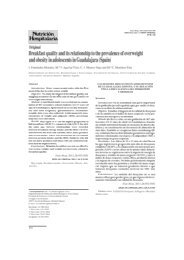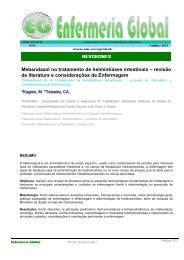Hamular Bursitis and its possible craniofacial referred ...
Hamular Bursitis and its possible craniofacial referred ...
Hamular Bursitis and its possible craniofacial referred ...
You also want an ePaper? Increase the reach of your titles
YUMPU automatically turns print PDFs into web optimized ePapers that Google loves.
Oral Medicine <strong>and</strong> Pathology <strong>Hamular</strong> <strong>Bursitis</strong>: Two case study report<br />
<strong>Hamular</strong> <strong>Bursitis</strong> <strong>and</strong> <strong>its</strong> <strong>possible</strong> <strong>craniofacial</strong> <strong>referred</strong> symptomatology:<br />
Two case reports<br />
Luis Miguel Ramírez 1 , Luis Ernesto Ballesteros 2 , German Pablo S<strong>and</strong>oval 3<br />
(1) Doctor of Odontology with a degree in Prosthetic Dentistry <strong>and</strong> Temporom<strong>and</strong>ibular Disorders in Universidad Javeriana– Santa Fe<br />
de Bogota - Colombia. Medical Education in Orofacial-Otic <strong>referred</strong> symptoms. Associate Professor of Morphology in the Department<br />
of Basic Sciences of the Medicine Faculty - Universidad Industrial de Sant<strong>and</strong>er (UIS) - Bucaramanga - Colombia<br />
(2) Medical Doctor with Degree in Anatomy. Basic Sciences Department Director, Professor of Morphology in the Department of Basic<br />
Sciences of the Medicine Faculty - Universidad Industrial de Sant<strong>and</strong>er (UIS) - Bucaramanga - Colombia<br />
(3) Medical Doctor with degree in Otolaryngology from Hospital Militar- Santa Fe de Bogota - Colombia. Surgery Professor of the<br />
Medicine Faculty - Universidad Industrial de Sant<strong>and</strong>er (UIS) - Bucaramanga - Colombia. Otolaryngology <strong>and</strong> head-neck surgery’s<br />
Chief of Carlos Ardila Lule Clinic<br />
Correspondence:<br />
Dr. Luis Miguel Ramirez<br />
Departamento de Ciencias Básicas<br />
Universidad Industrial de Sant<strong>and</strong>er.<br />
Bucaramanga – Colombia<br />
E-mail: lmra@epm.net.co<br />
Received: 21-08-2004<br />
Accepted: 9-10-2005<br />
Indexed in:<br />
-Index Medicus / MEDLINE / PubMed<br />
-EMBASE, Excerpta Medica<br />
-Indice Médico Español<br />
-IBECS<br />
E329<br />
Ramirez LM, S<strong>and</strong>oval GP, Ballesteros LE. <strong>Hamular</strong> <strong>Bursitis</strong> <strong>and</strong> <strong>its</strong><br />
<strong>possible</strong> <strong>craniofacial</strong> <strong>referred</strong> symptomatology: Two case reports. Med<br />
Oral Patol Oral Cir Bucal 2006;11:E1-5. Med Oral Patol Oral Cir Bucal<br />
2006;11:E329-33.<br />
© Medicina Oral S. L. C.I.F. B 96689336 - ISSN 1698-6946<br />
ABSTRACT<br />
The diagnosis of <strong>craniofacial</strong> pain is conditioned by the interdisciplinary management of <strong>its</strong> presentation especially in the<br />
absence of unique <strong>and</strong> objective signs. <strong>Bursitis</strong> is a pathological entity recently found in the hamular area <strong>and</strong> should be<br />
included in the diagnosis for exclusion of temporom<strong>and</strong>ibular disorders (TMD), ear-nose-throat pathologies, due to the<br />
similar symptomatology to other head <strong>and</strong> neck conditions. The hamular process bursitis is a painful condition that can<br />
easily be confused with glosopharinge or trigeminal neuralgia that generates an uncomfortable feeling in the oropharinge<br />
with ipsilateral <strong>referred</strong> – heteretopic - symptomatology to the head. This pathology, in chronic states, can be responsible<br />
for the amplification of the pain perceived by the central excitation effect. In this report are presented two clinical cases<br />
of hamular bursitis <strong>and</strong> <strong>its</strong> conservative therapeutic management. The recognition of the inflammation of the bursa of<br />
the tensor veli palati muscle supplies the specialist with another tool in the management of <strong>craniofacial</strong> pain.<br />
Key words: <strong>Bursitis</strong>, pterygoid hamulus, <strong>referred</strong> pain, temporom<strong>and</strong>ibular disorders.<br />
RESUMEN<br />
El diagnostico del dolor craneofacial esta condicionado al manejo interdisciplinario por lo confuso de su presentación<br />
especialmente en la ausencia de signos únicos y objetivos. La bursitis es una entidad patológica recientemente notificada<br />
en la zona hamular y que debe ser vinculada al diagnostico por exclusión en desordenes temporom<strong>and</strong>ibulares (DTM) y<br />
patologías de oído, nariz y garganta, debido a la sintomatología similar a la de otras condiciones que afectan la región<br />
de cabeza y cuello. La bursitis del proceso hamular es un patología dolorosa que puede fácilmente ser confundida con<br />
neuralgia del glosofaríngeo o del trigémino que genera gran incomodidad en la orofaringe con sintomatología heterotopica<br />
referida y patrón ipsilateral a cara. Esta patología en estados crónicos puede ser responsable de la amplificación del<br />
dolor percibido por efecto de excitación central. En este reporte se presentan dos casos clínicos de <strong>Bursitis</strong> <strong>Hamular</strong> y<br />
su manejo terapéutico conservador. El reconocimiento de la inflamación de la bursa del tendón del músculo tensor del<br />
velo palatino suministra al especialista una herramienta más en el manejo del dolor craneofacial.<br />
Palabras clave: <strong>Bursitis</strong>, hamulus pterigoideo, dolor referido, desordenes temporom<strong>and</strong>ibulars.<br />
Click here to view the<br />
article in Spanish<br />
© Medicina Oral S.L. Email: medicina@medicinaoral.com
Med Oral Patol Oral Cir Bucal 2006;11:E329-33. <strong>Hamular</strong> <strong>Bursitis</strong>: Two case study report<br />
INTRODUCTION<br />
Throat pain is one of the most difficult to diagnose because<br />
of <strong>its</strong> varied origins that could be vascular, muscular, ligamental<br />
or osseous. In the last 34 years different investigators<br />
(1,2) have come to observe irritation in the palatine area that<br />
corresponds to the hamular process with a <strong>referred</strong> symptomatic<br />
expression to the head <strong>and</strong> neck zones. Salins (3) in<br />
1989 explained the inflammation of the bursa that covers the<br />
tendon of the tensor veli palati – external perystaphylinus<br />
muscle – as hamular bursitis.<br />
<strong>Hamular</strong> bursitis (4) is a pathological entity that when it is<br />
present is primarily responsible for <strong>referred</strong> <strong>craniofacial</strong> pain,<br />
many times disguised as TMD disorders, impacted teeth,<br />
trigeminal <strong>and</strong> glossopharyngeal neuralgia, stylo-hyoid ligament<br />
calcification, stylo-m<strong>and</strong>ibular ligament inflammation,<br />
tumors, cysts, herpes simplex, infection <strong>and</strong> otitis media.<br />
Salins (3) named the inflammation of this bursa as “bursitis<br />
hamular”. This pathology has a multiple etiology <strong>and</strong> is<br />
formed over the hamular process of the medial pterygoid<br />
plate in the sphenoid bone.<br />
It must be understood that the close anatomical <strong>and</strong> physiological<br />
relation between the Eustachian tube, the tensor<br />
veli palati muscle, <strong>and</strong> the pterygoid hamulus correlates the<br />
local <strong>and</strong> <strong>referred</strong> symptomatology of this pathology.<br />
The sphenoid bone is a middle osseous structure located<br />
anterior to the basilar portion of the occipital bone <strong>and</strong><br />
bilateral shielded by the temporal bone. It has a central body<br />
with a pair of great <strong>and</strong> small wings going laterally with<br />
two pterygoid plates – inner <strong>and</strong> outer - descending from<br />
the union of the body <strong>and</strong> the bigger wings. The pterygoid<br />
plates go caudally in a vertical <strong>and</strong> lateral way, going more<br />
inferior the medial plate that terminates in the hamular<br />
process (Figure1).<br />
Fig. 1. Pterygoid Hamulus (Arrow).<br />
The tensor veli palati <strong>and</strong> medial pterygoid muscles are<br />
contained in the medial surface of the medial pterygoid plate<br />
(5). The lateral zone of tensor veli palate originates in the<br />
sphenoid spine, the scaphoid fossa, the tensor tympani muscle<br />
<strong>and</strong> the lateral osseous edge of the sphenoid sulcus. The<br />
© Medicina Oral S.L. Email: medicina@medicinaoral.com<br />
E330<br />
medial zone of the tensor veli palati muscle – tubae dilator<br />
– described by Gray in 1918 (6) is originated in the middle<br />
<strong>and</strong> posterior third of the Eustachian tube’s membranous<br />
wall. These muscles descend toward the lateral surface of<br />
the superior pharyngeal constrictor <strong>and</strong> are internal to the<br />
medial pterygoid muscle <strong>and</strong> converge in a strong tendon<br />
to the pterygoid hamulus bending around it in a lateral way<br />
<strong>and</strong> finally goes medially <strong>and</strong> horizontally to the soft palate<br />
to form <strong>its</strong> aponeurosis in a fan shaped expansion. This<br />
aponeurosis fusion the posterior border of hard palate <strong>and</strong><br />
the aponeurosis of the contralateral homonymous muscle.<br />
Due to the lateral insertion of the tube dilator muscle on<br />
the Eustachian tube, it pulls directly to <strong>its</strong> membranous<br />
wall <strong>and</strong> indirectly rotates the tubaric cartilage, opening the<br />
Eustachian tube lumen (7,8) allowing middle ear ventilation<br />
<strong>and</strong> atmospheric pressure equalization (9). These muscles<br />
are motor innervated by the m<strong>and</strong>ibular branch of the<br />
trigeminal nerve <strong>and</strong> sensorial innervated by the maxillar<br />
branch of the same cranial pair.<br />
The hamulus pterygoid or hamular process corresponds to<br />
the terminal part of the medial pterygoid plate. It has a hook<br />
form located bilaterally in the sphenoid bone medial <strong>and</strong><br />
posterior to the maxillar tuberosity. This structure projects<br />
inferior, posterior <strong>and</strong> laterally. Morphologically <strong>its</strong> form,<br />
length <strong>and</strong> width are varied with a bulbous or thin termination.<br />
The contraction of tensor veli palati muscle tension the<br />
soft palate <strong>and</strong> opens the Eustachian tube during speaking,<br />
swallowing, chewing, breathing, yawning <strong>and</strong> sneezing. The<br />
superior pharyngeal constrictor muscle <strong>and</strong> the buccinator<br />
muscle are confronted in the pterygo-m<strong>and</strong>ibular raphe<br />
that originates in the hamulus process <strong>and</strong> originate in the<br />
m<strong>and</strong>ibular posterior mylohyoid line. In the same way a<br />
portion of the palate-pharyngeal muscle originates in the<br />
hamular process.<br />
Shankl<strong>and</strong> (10,11) in 1996 proved the histological presence<br />
of the hamular process bursa (Figure 2). The principal<br />
function of this bursa is to diminish the friction over the<br />
hamular process by the tendon of tensor veli palati muscle<br />
during <strong>its</strong> function. (12)<br />
The damage of this structure produces inflammation <strong>and</strong><br />
pain - local or <strong>referred</strong> – during the soft palate function. Its<br />
etiology is not known but the trauma history is very common<br />
in the bursitis hamular patients. Anesthesia intubations,<br />
swallowing a big bolus, overextended maxillar prothesis, the<br />
traumatic strike during teeth brushing, bulimic patients <strong>and</strong><br />
“fellatio” in child sexual abuse, can generate this pathological<br />
state. The pain can be retarded <strong>and</strong> worsened by patient<br />
digital or tongue palpation. Some times the patient has a<br />
clinical presentation similar to glossopharyngeal neuralgia<br />
reporting incapacity to swallow solid food that forces them<br />
to ingest liquids. If the hamular process is prominent these<br />
patients will be easily prone to trauma.<br />
<strong>Bursitis</strong> pain is varied: earache, otic fullness, dysphagia, odynophagia,<br />
gustative hyperesthesia, hamular <strong>and</strong> soft palate pain,<br />
sore throat, jaw pain, toothache, burning <strong>and</strong> pricking dysaesthesias,<br />
retro-orbital pain, headaches <strong>and</strong> hypoesthesia.<br />
<strong>Hamular</strong> process palpation is made by oral access, manually
Oral Medicine <strong>and</strong> Pathology <strong>Hamular</strong> <strong>Bursitis</strong>: Two case study report<br />
(13) or with a blunt instrument in a careful manner reaching<br />
the posterior <strong>and</strong> medial zone of the maxillar tuberosity.<br />
The reported pain is frequently localized to the ear zone,<br />
but it must be asked if a local or <strong>referred</strong> pattern is present<br />
during the examination. If the palpation procedure response<br />
is intense, it must be considered a hamular bursitis cause.<br />
Lidocaine infiltration in the hamular process zone helps in<br />
the diagnosis. Some times the eythematic presentation in the<br />
zone <strong>and</strong> the elongation of the process is evident.<br />
The response by the pharmacological management (anticonvulsants,<br />
muscular relaxants, NSAIDs) is poor (4,11). The<br />
therapeutic phase can be surgical or conservative (infiltrations).<br />
The local trauma origin must be eliminated <strong>and</strong> a soft diet<br />
suggested. The infiltration of 1 ml of synthetic cortisone with<br />
previous anesthesia is suggested (Figure 3). Post-infiltration<br />
NSAIDs is recommended. After two weeks it is suggested a<br />
second infiltration control be given if the pain has not been<br />
eliminated; this situation is not frequent.<br />
Fig. 2. <strong>Hamular</strong> bursa (cranial inferior view).<br />
A- Tensor veli palati insertion B- Styloid process<br />
C- Eustachian tube insertion of medial zone of<br />
tensor veli palati muscle D- Bursa E- Tensor veli<br />
palati tendon F- Palatine aponeurosis G- Pterigom<strong>and</strong>ibular<br />
raphe. Modified from: (10)<br />
Fig. 3. Bursa <strong>and</strong> hamular process zone Infiltration.<br />
E331<br />
CLINIC CASES<br />
Case 1<br />
A 43 year old woman consulted her doctor because of left facial<br />
pain expressed in several zones: auricular, pre-auricular,<br />
temporal, masseterine, m<strong>and</strong>ibular body <strong>and</strong> angle. Local<br />
muscle soreness was found in lateral pterygoids, left medial<br />
pterygoid, left superficial masseter, deep masseters besides<br />
the right joint reduced luxation in a chronic state <strong>and</strong> trigger<br />
points in trapezius muscles. The otic <strong>referred</strong> symptoms are:<br />
otalgia, tinnitus, vertigo y left fullness without localized<br />
ear nose or throat pathology. In a previous medical consult<br />
the patient was prescribed anticonvulsive drugs without<br />
resolution of a <strong>possible</strong> trigeminal neuralgia besides the<br />
inefficiency of NSAIDs drugs. In the left hamular process<br />
palpation the patient report intense local pain <strong>and</strong> diffuse<br />
pain to the left facial area. It was anesthetized in the palatine<br />
zone correspondent with the hamular zone <strong>and</strong> the pain<br />
was eliminated. An infiltration with synthetic cortisone was<br />
programmed after the lidocaine block. After the alleviation<br />
of this hamular pain a muscular tension suppression system<br />
was inserted for the muscular involvement of the TMD that<br />
appears to produce an otic <strong>referred</strong> symptomatology (14).<br />
The patient’s pain has been controlled for 2 years without<br />
the recurrence of her original complaints. The <strong>referred</strong><br />
otalgia was not solved with infiltration maybe due to the<br />
acute pain that was produced on the maxillar branch of the<br />
trigeminal nerve; however, a <strong>possible</strong> explanation may start<br />
on the bursa pain co-contraction muscular activity that can<br />
involve the tensor tympani <strong>and</strong> tensor veli palati muscles<br />
<strong>and</strong> can produce tympanic tension in a muscle-skeletal complex<br />
scenario. Would it be that a bio-psychosocial context<br />
additional to the palatine pain can trigger this muscular<br />
hyperactivity with <strong>its</strong> <strong>referred</strong> expression?<br />
Case 2<br />
A 52 year old woman with otic <strong>and</strong> <strong>craniofacial</strong> <strong>referred</strong><br />
symptomatology (left otalgia, bilateral tinnitus, vertigo,<br />
bilateral fullness, left scalp pain <strong>and</strong> bilateral neck pain)<br />
came to consult. From the otolaryngology exam there<br />
wasn’t any ear, nose or throat pathology found. A muscleskeletal<br />
compromise is found with local muscle soreness in:<br />
lateral pterygoids, temporalis, posterior digastrics, bilateral<br />
sternocleidomastoids, splenius, <strong>and</strong> left occipitofrontalis.<br />
Additionally, trigger points in bilateral trapezius were found.<br />
During swallowing <strong>and</strong> chewing the patient expressed pain.<br />
Moreover, tooth phantom pain was found in m<strong>and</strong>ibular<br />
left molars (without pathology), palate burning sensation<br />
<strong>and</strong> scalp secondary hyperalgesia forcing us to recognize a<br />
<strong>possible</strong> neuropathic presentation of the symptoms. The<br />
patient expressed a metallic taste sensation periodically. To<br />
the left hamular process palpation the pain was triggered<br />
locally <strong>and</strong> <strong>referred</strong> to the left m<strong>and</strong>ibular <strong>and</strong> otic zones.<br />
Synthetic cortisone was injected in the left hamulus with a<br />
previous local anesthesia. After the pain was eliminated <strong>and</strong><br />
1 month after infiltrations a muscular tension suppression<br />
system device was designed for the TMD treatment. The<br />
controls have been in place for 18 months without recur-<br />
© Medicina Oral S.L. Email: medicina@medicinaoral.com
Med Oral Patol Oral Cir Bucal 2006;11:E329-33. <strong>Hamular</strong> <strong>Bursitis</strong>: Two case study report<br />
rence of the original symptomatology. The muscle-skeletal<br />
compromise may have the same concomitant association<br />
between bio-psychosocial dimension <strong>and</strong> muscle activity<br />
of the anterior case.<br />
DISCUSSION<br />
Throat pain can be originated in several associated structures<br />
that dem<strong>and</strong> a deep examination. The diagnosis is a<br />
critical process in which the error or omission produce a<br />
diagnosis treatment failure. An exclusion diagnosis is important<br />
emphasizing in the clinical history that includes a<br />
physical examination. The physical <strong>and</strong> visual examination<br />
of head <strong>and</strong> neck associated structures is vital: temporom<strong>and</strong>ibular<br />
joint, cranial <strong>and</strong> cervical musculature, stylo-hyoid<br />
<strong>and</strong> stylo-m<strong>and</strong>ibular complex, temporal tendon, sphenopalatine<br />
ganglion <strong>and</strong> parotid gl<strong>and</strong> among others. The<br />
above pathologies have a similar symptomatic expression<br />
like the hamular bursitis.<br />
The radiological support as images can be useful for the<br />
findings of osteophytes or hamulus that generate inflammation.<br />
This structure can be seen also in tomography slices<br />
if necessary.<br />
The surgical approach is rare due to the successful results<br />
of a conservative management. If osteophytes, prominent<br />
hamular process or bursa fibrosis are present the surgical approach<br />
will be indicated, avoiding carefully the interruption<br />
of the tensor veli palati function over this osseous hook as<br />
in total hamulotomy that results in tubaric dysfunction with<br />
otic expression as hypoacusis besides of a palate-pharynx<br />
seal incomplete during speaking <strong>and</strong> swallowing (15).<br />
As it can be observed in the expressed symptomatology<br />
of both patients the bursitis hamular <strong>and</strong> it’s <strong>referred</strong> otic<br />
symptoms component were present. The pathophysiology<br />
explanation for it can be focused in the common neural<br />
motor connections between the stomatognathic <strong>and</strong> otic<br />
system that can produce extra-activity in the middle ear<br />
with <strong>its</strong> consequences: vertigo, tinnitus, otalgia, hypoacusis<br />
<strong>and</strong> fullness. Although a major muscular activity can be<br />
expected during pain states as a protective mechanism in<br />
the clinical cases presented the concomitance between pain<br />
<strong>and</strong> the TMD is not the expected cause-effect relationship.<br />
It is <strong>possible</strong> that the TMD found in both patients would<br />
be originated before the bursitis hamular pain as a result<br />
of another scenario like the bio-psychosocial due to the<br />
cognitive-emotional changed dimension found in both patients.<br />
The use of muscular tension suppression devices as<br />
an adjunct treatment beside the infiltration procedure have<br />
proved to provide good results. Any velo-pharynx movement<br />
in the hamular zone will produce pain because it is an<br />
area especially exposed to any swallowing movement. The<br />
above mentioned makes the tensor veli palati muscle non<br />
functional due to <strong>its</strong> contraction to open the Eustachian<br />
tube, will produce more pain <strong>and</strong> patient avoidance of this<br />
scenario will void the pressure equilibration of the middle<br />
ear <strong>and</strong> generate otic symptoms if not corrected.<br />
The hamular zone deserves special clinical attention espe-<br />
© Medicina Oral S.L. Email: medicina@medicinaoral.com<br />
E332<br />
cially in the differential diagnosis of the wide variety of<br />
cranio-cervical pains. The pain in this zone is so intense<br />
that it can be confused as neuropathic pain. The opportune<br />
treatment in this zone avoids the central excitatory effect <strong>and</strong><br />
neuro-plasticity that will make more complex the localization<br />
of the pathology origin due to the major sensitization<br />
<strong>and</strong> territory expressed during pain episodes.<br />
In the two clinical cases exposed were combined pathologies<br />
involving bursitis <strong>and</strong> TMD. Interdisciplinary management<br />
is imperative for the resolution of these painful syndromes<br />
under a bio-psychosocial model that explains the stressmuscle<br />
pathophysiology connection <strong>and</strong> the somber origin<br />
of the hamular bursitis for a proper solution.
Oral Medicine <strong>and</strong> Pathology <strong>Hamular</strong> <strong>Bursitis</strong>: Two case study report<br />
REFERENCES<br />
1. Hertz RS. Pain resulting from elongated pterygoid hamulus: Report of<br />
case. J Oral Surg 1968;26:209-10<br />
2. Wooten JW, Tarsitano JJ, Reavis DK. The pterygoid hamulus: a <strong>possible</strong><br />
source of swelling, erythema <strong>and</strong> pain: report of three cases. J Am Dent<br />
Assoc 1970;81:688-90<br />
3. Salins PC, Bloxham GP. <strong>Bursitis</strong>: a factor in the differential diagnosis<br />
of orofacial neuralgias <strong>and</strong> myofascial pain dysfunction syndrome. Oral<br />
Surg Oral Med Oral Pathol 1989;68:154-7<br />
4. Shankl<strong>and</strong> WE. Pterygoid hamulus bursitis: one cause of <strong>craniofacial</strong><br />
pain. J Prosthet Dent 1996;75:205-10<br />
5. Ross MA. Functional anatomy of the tensor palati. Arch Otolaryngol<br />
1971;93:1-3<br />
6. Williams PL, Warwick R, Dyson M, Bannister LH, eds. Gray’s anatomy.<br />
37 th ed. Edinburgh, Scotl<strong>and</strong>: Churchill Livingston; 1989. p. 1113-227.<br />
7. Spauwen PH, Hillen B, Lommen E, Otten E.Three-dimensional computer<br />
reconstruction of the eustachian tube <strong>and</strong> paratubal muscles. Cleft<br />
Palate Craniofac J 1991;28:217-9<br />
8. Huang MH, Lee ST, Rajendran K.A fresh cadaveic study of the paratubal<br />
muscles: implications for eustachiatube function in cleft palate. Plast<br />
Reconstr Surg 1997;100:833-42<br />
9. Misurya VK. Functional anatomy of tensor palati <strong>and</strong> levator palati<br />
muscles. Arch Otolaryngol 1976;102:265-70<br />
10. Shankl<strong>and</strong> WE. <strong>Bursitis</strong> of the hamular process. Part I: Anatomical<br />
<strong>and</strong> histological evidence. Cranio 1996;14:186-9.<br />
11. Shankl<strong>and</strong> WE. <strong>Bursitis</strong> of the hamular process. Part II: Diagnosis,<br />
treatment <strong>and</strong> report of three cases studies. Cranio 1996;14:306-11.<br />
12. Putz R, Kroyer A. Functional morpholgy of the pterygoid hamulus.<br />
Anat Anz 1999;181:85-8.<br />
13. Brook IM. Pterygoid hamulus hyperawareness. Br Dent J<br />
1982;153:150.<br />
14. Shankl<strong>and</strong> WE. Migraine <strong>and</strong> tension-type headache reduction<br />
through pericranial muscular suppression: a preliminary report. Cranio<br />
2001;19:269-78<br />
15. Noone RB, R<strong>and</strong>all P, Stool SE, Hamilton R, Winchester RA. The<br />
effect of middle ear disease of fracture of the pterygoid hamulus during<br />
palatoplasty. Cleft Palate J 1973;10:23-33.<br />
E333<br />
© Medicina Oral S.L. Email: medicina@medicinaoral.com


